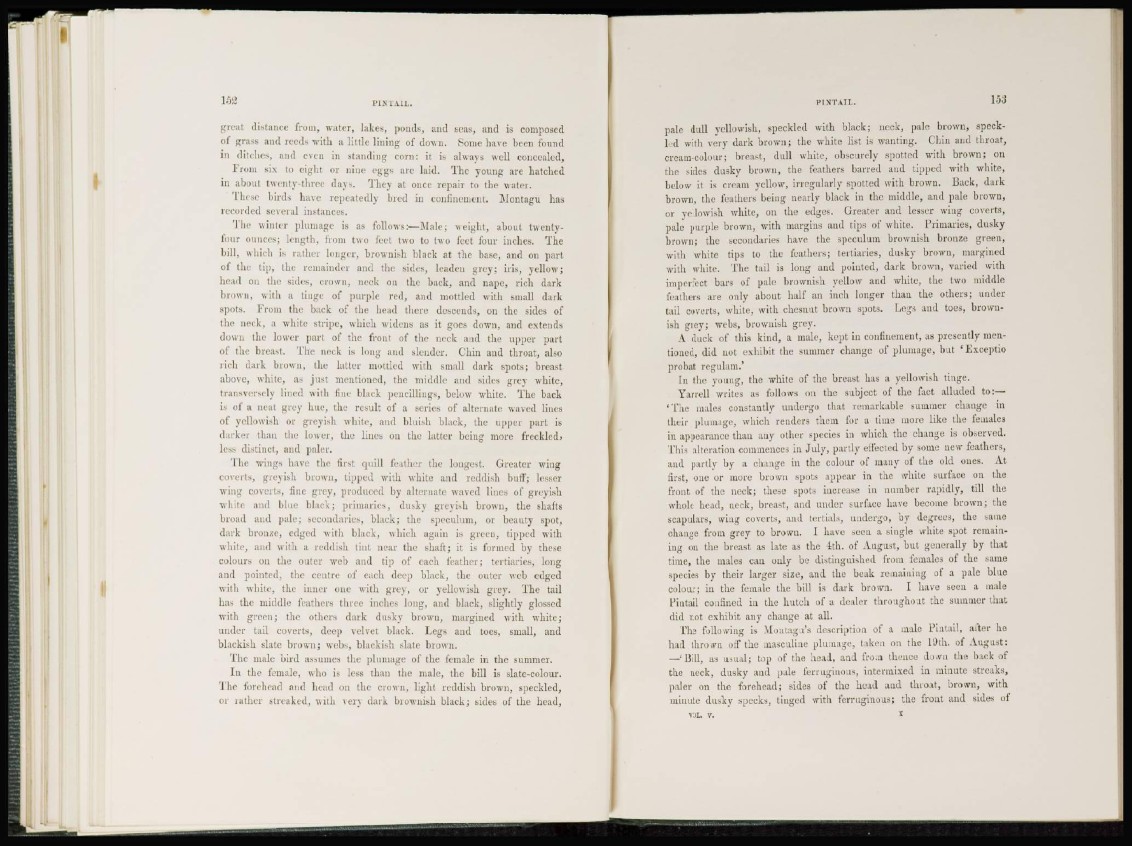
great distance from, water, lakes, ponds, and seas, and is composed
ol grass and reeds with a little lining of down. Some have been found
in ditches, and even in standing corn: it is always well concealed,
From six to eight or nine eggs are laid. The young are hatched
in about twenty-three days. They at once repair to the water.
These birds have repeatedly bred in confinement. Montagu has
recorded several instances.
'1 he winter plumage is as follows:—Male; weight, about twentyfour
ounces; length, from two feet two to two feet four inches. The
bill, which is rather longer, brownish black at the base, and on part
of the tip. the remainder and the sides, Leaden grey; iris, yellow;
head on the sides, crown, neck on the back, and nape, rich dark
brown, with a tinge of purple red, and mottled with small dark
spots. From the back of the head there descends, on the sides of
the neck, a white stripe, which widens as it goes down, and extends
down the lower part of the front of the neck and the upper part
of the breast. The neck is long and slender. Chin and throat, also
rich dark brown, the latter mottled with small dark spots; breast
above, white, as just mentioned, the middle and sides grey white,
transversely lined with fine black pencillings, below wdiite. The back
is ol' a neat grey hue, the result of a series of alternate -waved lines
of yellowish or greyish white, and bluish black, the upper part is
darker than the lower, the lines on the latter being more freckled*
less distinct, and paler.
The wings have the first quill feather the longest. Greater wing
coverts, greyish brown, tipped with wdiite and reddish buff; lesser
wing coverts, fine grey, produced by alternate waved lines of greyish
white and blue black; primaries, dusky greyish brown, the shafts
broad and pale; secondaries, black; the speculum, or beauty spot,
dark bronze, edged with black, which again is green, tipped with
white, and with a reddish tint near the shaft; it is formed by these
colours on the outer web and tip of each feat her; tertiaries, long
and pointed, the centre of each deep black, the outer web edged
with white, the inner one with grey, or yellowish grey. The tail
has the middle feathers three inches long, and black, slightly glossed
with green; the others dark dusky brown, margined with white;
under tail coverts, deep velvet black. Legs and toes, small, and
blackish slate brown; webs, blackish slate brown.
The male bird assumes the plumage of the female in the summer.
I n the female, who is less than the male, the bill is slate-colour.
The forehead and head on the crown, light reddish brown, speckled,
ei rather streaked, with \ er\ dark brownish black; sides of the head,
pale dull yellowish, speckled with black; neck, pale brown, speckled
with very dark brown; the white list is wanting. Chin and throat,
cream-colour; breast, dull white, obscurely spotted with brown; on
the sides dusky brown, the feathers barred and tipped with white,
below it is cream yellow, irregularly spotted with brown. Back, dark
brown, the feathers being nearly black in the middle, and pale brown,
or vol lowish white, on the edges. Greater and lesser wing coverts,
pale purple brown, with margins and tips of white. Primaries, dusky
brown; the secondaries have the speculum brownish bronze green,
with white tips to the feathers; tertiaries, dusky brown, margined
with white. The tail is long ami pointed, dark brown, varied with
imperfect bars of pale brownish yellow and white, the two middle
feathers are only about half an inch longer than the others; under
tail coverts, white, with chesnut brown spots. Legs and toes, brownish
grey; webs, brownish grey.
A duck of this kind, a male, kept in confinement, as presently mentioned,
did not exhibit the summer change of plumage, but ' Exceptio
probat regulam.'
In the young, the white of the breast has a yellowish tinge.
Yarrell writes as follows on the subject of the fact alluded to:—
' T h e males constantly undergo that remarkable summer change in
their plumage, which renders them for a time more like the females
in appearance than any other species in which the change is observed.
This alteration commences in July, partly effected by some new feathers,
and partly by a change in the colour of many of the old ones. At
first, one or more brown spots appear in the white surface on the
front of the neck; these spotj increase in number rapidly, till the
whole head, neck, breast, and under surface have become brown; the
scapulars, wing coverts, and tertials, undergo, bv degrees, the same
change from grey to brown. I have seen a single white spot remaining
on the breast as late as the 4th. of August, but generally by that
time, the males can only be distinguished from females of the same
species by their larger size, and the beak remaining of a pale blue
colour; in the female the bill is dark brown. I have seen a male
Pintail coafined in the hutch of a dealer throughout the summer that
did not exhibit any change at all.
The following is Montagu's description of a male Pintail, after he
had thrown off the masculine plumage, taken on the 19th. of August:
—"13111, as usual; top of the head, and from thence down the back of
the neck, dusky and pale ferruginous, intermixed in minute streaks,
paler on the forehead; sides of the head and throat, brown, with
minute dusky specks, tinged with ferruginous; the front and sides of
VOL. v. £